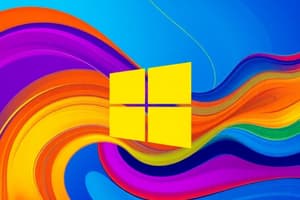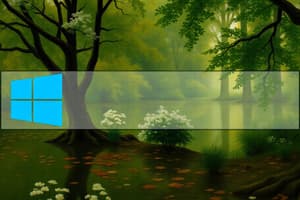Podcast
Questions and Answers
What type of system is Microsoft Windows?
What type of system is Microsoft Windows?
- Graphical operating system (correct)
- Real-time operating system
- Command-line operating system
- Network operating system
Who developed and published Microsoft Windows?
Who developed and published Microsoft Windows?
- Microsoft (correct)
- Apple Inc.
- IBM
What is a key feature of Microsoft Windows?
What is a key feature of Microsoft Windows?
- Allows graphical user interface navigation (correct)
- Uses primarily text-based commands
- Supports multiple users without restrictions
- Exclusive to mobile devices
Which statement accurately describes Microsoft Windows?
Which statement accurately describes Microsoft Windows?
How does Microsoft Windows differ from command-line operating systems?
How does Microsoft Windows differ from command-line operating systems?
What does a user-friendly interface primarily use for interaction?
What does a user-friendly interface primarily use for interaction?
Which of the following best describes a graphical user interface (GUI)?
Which of the following best describes a graphical user interface (GUI)?
What is one main advantage of using an interface that includes graphical elements?
What is one main advantage of using an interface that includes graphical elements?
What type of commands would be primarily absent in a graphical user interface?
What type of commands would be primarily absent in a graphical user interface?
Which of the following is NOT a characteristic of a user-friendly interface?
Which of the following is NOT a characteristic of a user-friendly interface?
What is the main advantage of a Graphical User Interface (GUI) in Windows?
What is the main advantage of a Graphical User Interface (GUI) in Windows?
What is one primary function of file management in Windows?
What is one primary function of file management in Windows?
Which of the following is NOT a component of file management in Windows?
Which of the following is NOT a component of file management in Windows?
Which statement best describes the purpose of the Windows GUI?
Which statement best describes the purpose of the Windows GUI?
How does a GUI contribute to file management in Windows?
How does a GUI contribute to file management in Windows?
What is the first step to install an application from a website?
What is the first step to install an application from a website?
What action should you take after finding the app in the settings to remove it?
What action should you take after finding the app in the settings to remove it?
Where do you need to navigate to uninstall an application?
Where do you need to navigate to uninstall an application?
What is a necessary step in the process of installing an app?
What is a necessary step in the process of installing an app?
What should you do if you want to delete an app from your device?
What should you do if you want to delete an app from your device?
What is the primary function of the This PC icon on the desktop?
What is the primary function of the This PC icon on the desktop?
Which of the following does the This PC icon NOT provide access to?
Which of the following does the This PC icon NOT provide access to?
What is the primary purpose of the Recycle Bin in a computer system?
What is the primary purpose of the Recycle Bin in a computer system?
Which of the following is NOT managed by a computer system's operating system?
Which of the following is NOT managed by a computer system's operating system?
Which icon serves as a central hub for managing computer storage?
Which icon serves as a central hub for managing computer storage?
Which function is associated with managing system preferences in an operating system?
Which function is associated with managing system preferences in an operating system?
What type of information can you find when accessing the This PC icon?
What type of information can you find when accessing the This PC icon?
Which statement best describes the role of the This PC icon?
Which statement best describes the role of the This PC icon?
What does the operating system commonly handle regarding hardware?
What does the operating system commonly handle regarding hardware?
Why is the Recycle Bin important in a computer system?
Why is the Recycle Bin important in a computer system?
Flashcards
Windows OS
Windows OS
A graphical operating system made by Microsoft.
Graphical OS
Graphical OS
An operating system that uses pictures and menus instead of text commands.
Operating System
Operating System
Software that manages computer hardware and software.
Microsoft
Microsoft
Signup and view all the flashcards
Lab One
Lab One
Signup and view all the flashcards
Graphical Interface
Graphical Interface
Signup and view all the flashcards
User Interaction
User Interaction
Signup and view all the flashcards
Windows, Icons, Menus
Windows, Icons, Menus
Signup and view all the flashcards
GUI
GUI
Signup and view all the flashcards
Text-Based Commands
Text-Based Commands
Signup and view all the flashcards
Computer Interaction
Computer Interaction
Signup and view all the flashcards
File Management
File Management
Signup and view all the flashcards
Windows
Windows
Signup and view all the flashcards
Applications
Applications
Signup and view all the flashcards
Store files
Store files
Signup and view all the flashcards
Download Installer
Download Installer
Signup and view all the flashcards
This PC Icon
This PC Icon
Signup and view all the flashcards
Computer Drives
Computer Drives
Signup and view all the flashcards
Run Installer
Run Installer
Signup and view all the flashcards
Uninstall App
Uninstall App
Signup and view all the flashcards
System Properties
System Properties
Signup and view all the flashcards
Connected Devices
Connected Devices
Signup and view all the flashcards
Apps & Features
Apps & Features
Signup and view all the flashcards
Computer Storage
Computer Storage
Signup and view all the flashcards
Find App
Find App
Signup and view all the flashcards
System Management
System Management
Signup and view all the flashcards
Recycle Bin
Recycle Bin
Signup and view all the flashcards
Computer Hardware
Computer Hardware
Signup and view all the flashcards
Software Management
Software Management
Signup and view all the flashcards
User Accounts
User Accounts
Signup and view all the flashcards
Study Notes
Information Technology (IT) LAB One
- Introduction to IT and Windows
What is Windows?
- Microsoft Windows is a graphical operating system created by Microsoft.
- It features a user-friendly interface using graphical elements like windows, icons, and menus instead of text-based commands.
Evolution of Windows
- Windows 1.0 (1985)
- Windows 95 (1995)
- Windows XP (2001)
- Windows Vista (2007)
- Windows 7 (2009)
- Windows 8 (2012)
- Windows 10 (2015)
- Windows 11 (2021)
Comparing Windows Versions
- Interface: Windows 7 uses a classic start menu and taskbar; Windows 8 uses a start screen with live tiles; Windows 10 uses a start menu with live tiles; and Windows 11 uses a centered start menu and taskbar.
- Performance: Windows 7 is stable and efficient; Windows 8 has faster boot times and improved security; Windows 10 offers improved performance and security; and Windows 11 is designed for enhanced performance and requires newer hardware.
- Cortana: Not available in Windows 7 and 8; integrated in Windows 10; and integrated in Windows 11.
- Microsoft Edge: Not available in Windows 7 and 8; available in Windows 10; and available in Windows 11.
- Support: Windows 7's support ended in January 2020; Windows 8's support ended in January 2016; Windows 10's support ends in October 2025; and Windows 11's support is ongoing.
Features of Windows
- Graphical User Interface (GUI): Easy navigation and use of various applications.
- File Management: Storing, organizing, and managing files and folders.
- Software Compatibility: Supports a wide range of applications (productivity tools to games).
- Internet Connectivity: Built-in tools for web browsing, email, and internet connection.
- Multitasking: Ability to run multiple applications simultaneously and switch between them.
- Security: Includes features like Windows Defender, firewalls, and regular updates to protect against malware.
Windows Interface Walkthrough
-
Taskbar: Provides quick access to applications, system notifications, and settings.
-
Start Menu: Central hub for accessing installed programs, files, settings, and more.
- Components: Search bar, pinned programs, all apps/programs, user account, and power options.
Applications (Installing and Uninstalling)
-
Installing:
- Microsoft Store: Search for the app and install.
- Website: Download the installer file and run it.
-
Uninstalling:
- Start Menu: Find the app, right-click, and select "Uninstall".
- Settings: Apps > Apps & features > Find the app and click "Uninstall".
- Control Panel > Programs > Programs and Features: Find the app, right-click, and select "Uninstall".
Desktop & Icons
- This PC: Access to computer's drives, files, and system properties.
- User's Files: Shortcut to current user's personal folders (Documents, Pictures, Downloads).
- Control Panel: Access to system settings, hardware, software, user accounts, and preferences.
- Recycle Bin: Stores deleted items; can be restored or emptied.
- Network: Displays available network connections and allows management/troubleshooting.
Customizing Desktop
- Personalization options available within Settings.
Using Windows Explorer
- File Explorer (Windows 10 and later) is the file management application.
- It provides a graphical interface for accessing, managing, and organizing files and folders on the computer.
Using Windows Explorer Features
- Creating new folders.
- Cutting, copying, pasting, renaming, sharing, and deleting items.
Control Panel
- Setting adjustments for computer's settings.
- Access to system and security, network and internet, hardware and sound, and programs.
Settings
- Access to various settings within the operating system.
Troubleshooting Common Windows Issues
-
Slow performance: Restart the computer, check for updates, run a virus scan, and free up disk space.
-
Unable to open files: Check for errors, permissions, or corrupt files.
-
System crashes: Check hardware, software, or driver problems.
-
Network connectivity issues: Check network settings, cables, and devices, and troubleshoot internet connections.
Windows Keyboard Shortcuts
- Various shortcuts are available for different tasks (e.g., Ctrl + A: select all, Ctrl + C: copy, Ctrl + X: cut).
Windows Keyboard Shortcuts (additional)
- More shortcuts are covered for various functions, such as opening the search bar, opening various settings and programs, etc.
Studying That Suits You
Use AI to generate personalized quizzes and flashcards to suit your learning preferences.




